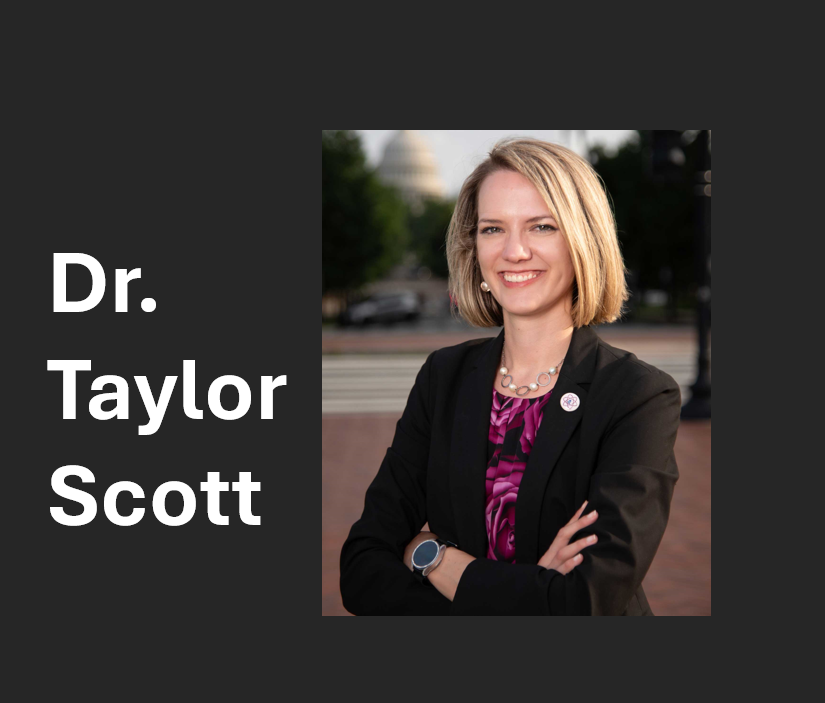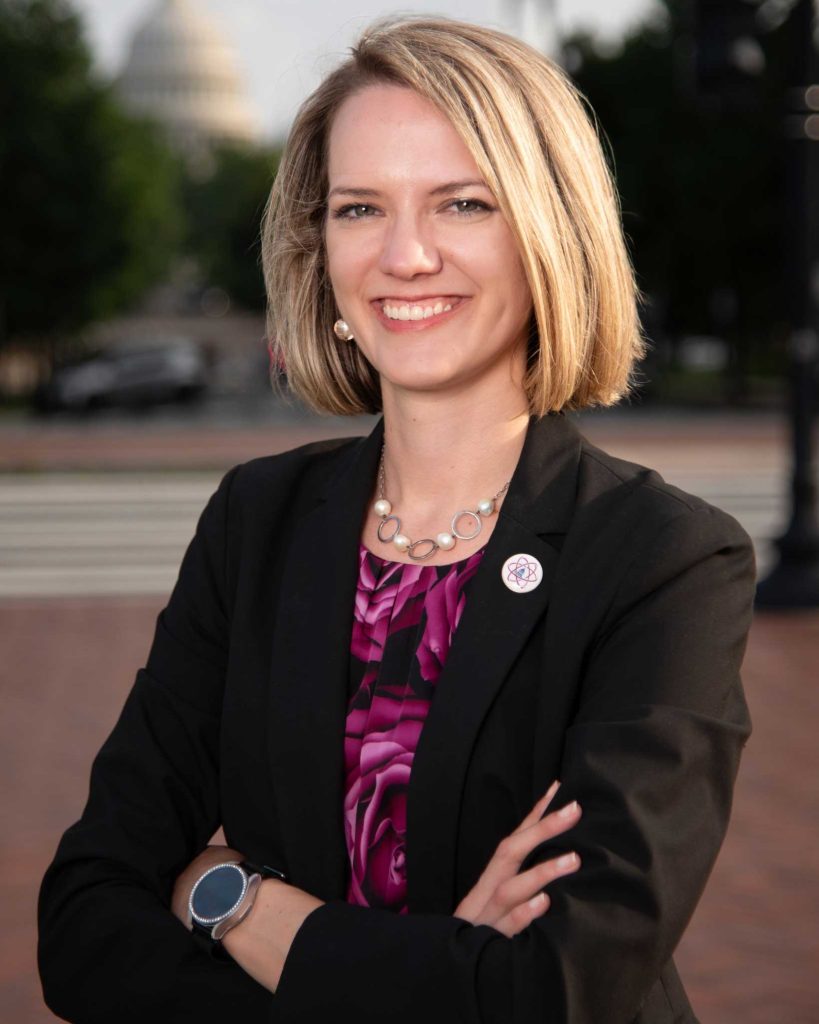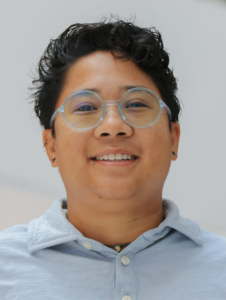
A conversation with Taylor Bishop Scott
In this interview, we sit down with Dr. Taylor Scott, Director of the Research Translation Platform at Penn State’s Evidence-to-Impact Collaborative and President of TrestleLink, to explore the critical intersections between research and policy. Dr. Scott has dedicated her career to building innovative models that bridge the gap between academic research and the real-world needs of policymakers. Through initiatives like the Research-to-Policy Collaboration (RPC), SciComm Optimizer for Policy Engagement, and Family Impact Seminars, she helps create pathways for researchers to influence policy decisions that affect thousands of lives.
Dr. Scott is not only focused on research but also actively applies models that bridge research and policy, overseeing studies to measure their effectiveness. As President of TrestleLink, she has developed plans for growth and sustainability while leading a fellowship program that gives junior scholars hands-on policy experience.
TrestleLink, which she founded, connects researchers with policymakers through nonpartisan services, enabling evidence-based decision-making without lobbying. Dr. Scott emphasizes building strong relationships between these communities, ensuring that research is relevant and timely for policymakers.
In this interview, Dr. Scott discusses the challenges and benefits of engaging policymakers with research, highlighting the importance of nonpartisan collaboration for better policy outcomes.
Talk about some of the primary goals and vision behind the research to policy collaboration model? So what, what are you trying to achieve with the center?
So, when I was in grad school, I took a policy class. It was very theoretical. At the same time, I was involved with the Society for Community Research and Action, where we did some policy work, like writing white papers. But it left me wondering: how do you actually do policy? How do you address things like gridlock?
At the same time, I was part of a lab that had findings showing how kids benefited in behavioral health when they had a case manager. Then, the general assembly decided not to fund case management services anymore. That made me realize something important: we can’t be completely upset about these decisions if we’re not part of the conversation that informs policymakers on what the data says about what works.
Did the general assembly have our findings? Did they have the evidence that case management was actually helping kids? Probably not. I wanted to be part of the solution, but I needed to understand how. So, as a practicum student, I helped launch and became a founding board member of the National Prevention Science Coalition.
As we formed the group, we started learning—through the literature—about how policymaking works and where there’s room to improve the integration of research into policy. We read this systematic review by Kathryn Oliver that laid out the theoretical components necessary for this process. One thing that really surprised us, and continues to surprise many people I consult with, is that you can’t just write your way out of this problem. It’s not a matter of writing more reports and expecting people to read them and have “aha” moments.
What’s really needed are relationships, partnerships, and collaboration. That’s how you get people thinking differently about issues and how you solve problems together. So, we asked: how do you facilitate this process?
We were fortunate to get seed funding from the Duke Foundation, and that’s when we started building relationships. This pilot project eventually evolved into what became the Research-to-Policy CollaborationTM model. It’s all based on the idea that we need more direct communication and coordination between the traditionally siloed worlds of policymakers and researchers.

You can’t build trust by charging in with your own agenda. True progress comes from building relationships, listening, and partnering with policymakers on their terms.
Dr. Taylor Scott
There’s 101 things to work on. So how do you identify which priorities and opportunities there are to engage researchers with policy makers? Where do you decide to focus your efforts?
“We start with the policymakers and focus on their goals in these areas. The way I operate—and the way the model is designed—is to be flexible and able to adjust to the current political landscape. Instead of trying to force change or convince people to go in a completely different direction, we aim to ride the wave of what’s already in motion.
In that sense, we work with what I call ‘umbrella topics.’ For example, I can work with people on welfare or substance use, but the key is finding a bipartisan group of legislators who care about those issues and understanding their goals and priorities. This approach works not just because it aligns with the theory of change—that policies tend to move when certain opportunity windows open—but also because it builds trust and working relationships.
By working with someone regardless of their ideology and within the framework of their current goals, we foster a partnership that’s more effective. It’s about embracing collaboration rather than trying to impose a different agenda
That just gave me an ‘aha’ moment—something I hadn’t realized about your work before. Traditionally, when we learn about policy advocacy, the approach is to develop a grassroots movement to raise awareness, and then try to get the attention of legislators or advocates to address an issue. But what you’re doing seems different. It sounds like you first look at what the policymakers are already working on, what’s already on their legislative agenda, and then you find ways to bring research and evidence into those existing efforts.
Yeah, it’s a rapid response mechanism and a process to create partnerships.
What are some of the common barriers that the average researcher faces when trying to engage with policymakers? And how do you think your model helps overcome those challenges
I think the biggest challenge is that we all live incredibly busy lives, whether it’s writing papers, applying for grants, or even coaching soccer teams. Unless you have a full-time policy job, none of us really have the time to sit down and monitor what legislators are working on, who the key policymakers are, or even how to get a meeting with them. Scheduling alone is an art—it requires persistence and often a full-time staff just to secure the kind of meetings we have on our books.
I would describe the main barrier as navigation. If it’s not part of your job, it’s really hard to figure out who’s who and what the opportunities are. It’s not that researchers never engage with policymakers, but it’s tough to do it on your own. That’s why having intermediary support is so important. It helps identify those opportunities so that researchers can simply show up at the right time, rather than trying to stay on top of everything themselves.
I’m really focused on readiness. How do you ensure that you’re not only building policymakers’ ability to use research in their work but also communicating the value and importance of being evidence-based in their policy development? How do you show them the advantages of using evidence in their decision-making?
Honestly, I don’t think it’s that difficult. It’s really about figuring out where someone is starting from. There’s always going to be a wide range of attitudes in any policymaking space—just like anywhere else. No group is monolithic. Some legislators are more active users of evidence, while others may be more focused on the politics of an issue. There’s a role for everyone on the chessboard.
The key is identifying who we can work with, and that’s part of the navigation process. That’s why we embrace the readiness framework. We even have a readiness assessment built into our policy associate needs assessment, which looks at two simple but important factors: whether the legislator is actively working on anything that that we have capacity to address, and their level of interest in partnering with researchers.
It’s not that we don’t try to work with people across all levels of readiness, but this framework helps us understand where we’re gaining traction and where the real opportunities are. We also try to be open and transparent about where our capacities lie. For instance, if we’re working on a substance use project and the legislator is more interested in healthcare access broadly, we may not have the capacity among our research partners to be able to be responsive.
At which level of government—state, municipal, or otherwise—do you see the greatest appetite for research or the best chance to make inroads with evidence-based policy?
All of the above. I believe the biggest barrier, and this is just my theoretical perspective, is a lack of interaction and rapport between researchers and policymakers. That’s what draws me to focus on more structural issues within academia. We could make our science much more useful if scientists were encouraged and incentivized to step outside the ivory tower and engage with real people in decision-making contexts. These partnerships can happen at the local level, like working with school boards, all the way up to Congress – each have different roles in making policy that affect community health.
I’ve run for school board a couple of times and interviewed for vacancies on both the school board and local municipal government. I’ve found that I often come across as knowledgeable, but too academic. When I try to focus on first principles—like asking, ‘What are we trying to achieve in our community?’ or ‘Do we have a vision for where we want to be in five years?’—that approach doesn’t seem to resonate. Instead, the conversation is more focused on immediate issues, like ‘How do we fix the golf course situation? So, I’ve realized that I need to work on developing better ways to connect with policymakers and communicate more effectively
Yeah, something that might give you a little relief comes from findings from using ‘small field experiments’ through the SCOPE model. We use this method for process evaluation to test different engagement strategies, which complements the RRP and other engagement strategies.
One interesting finding from our testing is that while people often say ‘jargon kills,’ in some cases, when a message came from a doctor using jargon, it was actually the most effective. Perhaps its because when scientists are authentically scientific in their messaging, it triggers genuine credibility. Across all of our findings, I’ve come to believe that if you can pair being true to who you are with a clear motivation for why you’re trying to help, it may actually connect with people and demonstrate the credibility of your expertise.
So, don’t be afraid to be your authentic scientific self. Of course, some people will respond to that, while others may not. It might also involve knowing your audience—who’s into that ‘nerdy’ stuff and who might be more focused on other concerns. Then you can adjust, using language and framing that works for different people.”
This ties into my last question. Given that there are varying priorities, value systems, and political views that policymakers bring to their work, how have you been able to maintain a nonpartisan approach and build productive relationships? I think you’ve touched on some of this already.
Yeah, I think the biggest thing is, it frustrates me when I hear a group of academics talk about ‘the politics’ in a dismissive way. My question is, how are you approaching people who don’t think like you? Are you saying, ‘Here’s what I think you should do, please do it’? Because that’s not how you build rapport, trust, or cooperation.
You can’t go in like a bull in a china shop and expect that approach to work. If you shift gears and focus on building rapport first—on finding mutual goals and ways to partner together—it becomes much more productive. But we can only do with the evidence we have available. Recently, I was talking internally with my staff about a policymaker who wanted more evidence on addressing drug supply chains, specifically to reduce fentanyl supply. There’s some evidence on this, but not a lot that we’re aware of. This led to an ‘aha’ moment about the kinds of research government funds doesn’t always answer every question policymakers are asking. I believe that if we engage with decision-makers earlier, before asking the research questions—similar to a community-based participatory research (CBPR) approach—we could solve a wider range of problems by informing more policy-relevant research as well.
Transform Your Knowledge in Minutes!
Our weekly newsletter delivers easy-to-read summaries of the latest public health research. Perfect for busy professionals or anyone who wants to stay informed without the jargon. Subscribe for free and take control of your knowledge today! Click below!



